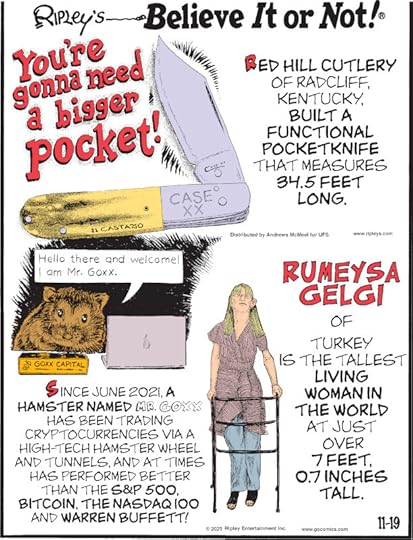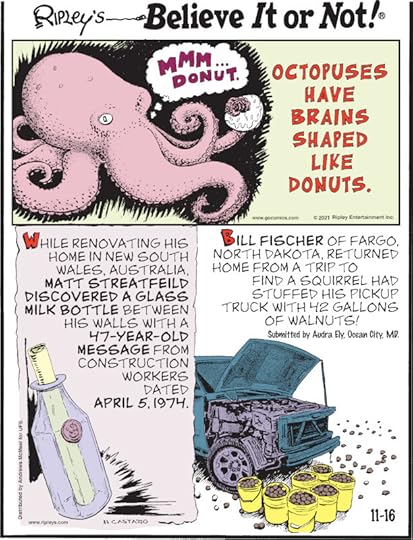Ripley Entertainment Inc.'s Blog, page 116
November 19, 2021
CARTOON 11-19-2021
November 18, 2021
Italy’s Altamura Man Reveals The Oldest Neanderthal DNA Ever Found
Featured in Ripley's Believe It or Not!

In 1993, a group of cave explorers in southern Italy stumbled across a grisly find: a human skull covered in a thick layer of calcite formations. The remains lie in what scientists call a karst borehole, where running water and limestone contributed to stalactite growth. For two decades, researchers left the bones untouched for fear of causing irreparable damage through attempted extraction.
As a result, archaeologists could do little more than theorize about the individual they dubbed “Altamura Man.” But recent advances have yielded far more information than scientists previously thought possible, rewriting critical details about this cave-bound individual.
Stuck Eternally in a WellHundreds of thousands of years ago, a Neanderthal met a cruel fate. Scientists believe he fell into a natural well where he got stuck and died. They hypothesize his demise came in the form of starvation or dehydration. Whatever the case, the cave system where he fell gradually took over, preserving his final resting place in a uniquely geological manner.
Over time, his skeletal remains became fused into stalactites rich in calcite, resulting in his current embedded state, covered with limestone deposits. For many years, scientists have speculated that the remains could be anywhere between 40,000 to 200,000 years old. Due to his precarious position, his skeleton has never been removed, with only his head and a part of one shoulder visible. This hasn’t left researchers with much to go on… until recently.

Close-up views of Altamura Man. Source: Riga A, et al. (2020) In situ observations on the dentition and oral cavity of the Neanderthal skeleton from Altamura (Italy). PLoS ONE 15(12): e0241713.
Dating Altamura ManThe Journal of Human Evolution reports that a team of scientists led by Giorgio Manzi at the Sapienza University of Rome recently acquired a genetic sample from the rock-encased man. They used uranium-thorium dating to reveal that the stalactite in which the skull is embedded dates to between 187,000 and 128,000 years ago.
These findings make Altamura Man the oldest Neanderthal bone sample to ever yield DNA. What’s up next for those working to solve the mystery of Altamura Man? They plan to test the sample DNA to find out whether it can be sequenced. If the DNA can be sequenced, they hope it will reveal significant new details about Neanderthals and their place in the history of humanity.
Inaccessible PreservationThese findings and their potential future applications prove excellent news for researchers who have found the Neanderthal’s current location largely inaccessible. You must descend on a 20-minute claustrophobia-inducing journey through narrow crevices to reach the man lodged permanently in the confined karst system. Of course, inaccessibility has come with a few perks. According to Jacopo Moggi-Cecchi, a University of Florence professor, “The original shaft he fell through is no longer there. It’s been filled by sediment, so we are confident the entire skeleton is there. No animals could have got there.”
Besides DNA information, Altamura Man has also provided researchers with fascinating details about his dental health. They’ve learned that he was a young adult with signs of some dental disease. He had two missing teeth and deposits of calcified dental plaque, which stand out from other Neanderthal samples tending to have excellent tooth health and no missing teeth. Some scientists hope that future technological advances will allow them to move past in situ examination of the remains. If Altamura Man could one day get safely removed, he could represent a wealth of new information about a formative branch of humanity’s family tree.

A view inside Altamura Man’s mouth. Source: Riga A, et al. (2020) In situ observations on the dentition and oral cavity of the Neanderthal skeleton from Altamura (Italy). PLoS ONE 15(12): e0241713.
By Engrid Barnett, contributor for Ripleys.com
EXPLORE THE ODD IN PERSON! Discover hundreds of strange and unusual artifacts and get hands-on with unbelievable interactives when you visit a Ripley’s Odditorium!Source: Italy’s Altamura Man Reveals The Oldest Neanderthal DNA Ever Found
CARTOON 11-18-2021
November 17, 2021
Painless Parker: The Man Who Turned Dentistry Into A Traveling Show
Featured in Ripley's Believe It or Not!

When Painless Parker came to town, the dentist was sure to put on quite a show.
On street corners across the U.S. and Canada in the late 19th and early 20th centuries, the scene alone was enough to grab your attention — a chair atop a horse-drawn wagon or stage; a middle-aged man dressed in a top hat, silk shirt, and white lab coat; and a small band ready to play at a moment’s notice.
Edgar Randolph “Painless” Parker typically attracted a big crowd, starting his show with a lecture about the importance of dental hygiene. Then, he made a bold offer: he would extract audience members’ teeth for 50 cents each. If the experience wasn’t pain-free, he said, he would give a $5 refund. One by one, his patients sat in the chair for all to see. Parker numbed their mouth with a cocaine solution before extracting a rotten tooth. The band’s blaring music distracted the patient and, should they scream, drowned out their wails.
Parker launched his dental shows in 1892, at a time when many people largely avoided going to the dentist in fear of the pain it could bring. He performed in numerous cities and turned the act of pulling teeth into a show. Believe It or Not!, the dentist once made a necklace out of 357 teeth he pulled in a single day. The necklace is on display today as part of the Historical Dental Museum Collection at the Temple University Kornberg School of Dentistry.

Copyright 2017, Kornberg School of Dentistry, Temple University
Parker is often remembered for his uncanny approach to dentistry, but some argue he left an important legacy in the field in other ways you might not expect. The American Dental Association (ADA) once described him as a “menace to the dignity of the profession.” Others view him in a more positive light. So, was he more of an unethical dentist or a patient advocate ahead of his time?
The Early DaysBorn in New Brunswick, Canada in 1872, Parker demonstrated a passion for salesmanship at an early age. As a young child, he bartered with a neighbor who gave him a hen and eggs in exchange for fresh fish, according to The Early Adventures of Painless Parker, a biography written from Parker’s perspective based on his writings and memorabilia. Salesmanship became one of Parker’s passions — and one that would serve him well years later as a traveling dentist.
In Parker’s late teenage years, his parents took him to a phrenologist, whom they believed could determine Parker’s mental capabilities by examining the bumps on his skull. The phrenologist said Parker was well suited for a career in dentistry. In 1889, he enrolled at the New York College of Dentistry, today the New York University College of Dentistry. At the time, the dental profession in the U.S. was “not well regulated,” says Dr. Andrew I. Spielman, professor and director of the Rare Book Library and Historical Archives at the NYU College of Dentistry.
Dr. Spielman, who’s also the president of the American Academy of the History of Dentistry, says a vast majority of those in the field at the time were either physicians who also practiced as dentists or simply people who started apprenticeship work with a dentist and then declared themselves open for business. Many lacked formal education and training.
“[They practiced] like a butcher working with someone for several years and, after a while, says, ‘OK, I’m ready now to put up my sign,’” Dr. Spielman says.
Living on tight funds as a student, Parker started going door to door in New York, cleaning people’s teeth for $1-2 and opened an office at just 18 years old, according to the biography. When word got back to the dental school dean that one of his students was practicing without a license, Parker was swiftly expelled.
Parker spent that summer as a traveling dentist in rural neighborhoods of New Brunswick, saving up enough money to enroll in fall 1890 in the Philadelphia Dental College, now the Temple University Maurice H. Kornberg School of Dentistry. There, the dean nearly refused to pass him but ultimately decided to give him a chance. So in 1892, Parker returned home to officially launch his career.
The Spark of an IdeaAfter setting up his practice in St. Martins, New Brunswick, Parker was disappointed when he attracted just a few patients. In those days, it was rare to go to the dentist for anything aside from a bothersome tooth.
Physicians and even barbers sometimes pulled teeth, and they were known to break some in the process. Many people didn’t understand that poor dental hygiene could have lasting consequences on their health.
In dentistry’s early days, “People avoided dentists as dentists were considered synonymous with pain,” says Parker’s biography co-author Dr. Peter Pronych, a retired dentist who once served on the Faculty of Dentistry at Dalhousie University in Nova Scotia, Canada, and has researched and written extensively about Parker’s life with Dr. Arden G. Christen, Professor Emeritus at the Indiana University School of Dentistry. Novocain, which is widely used today, wasn’t invented until around 1905. Dr. Pronych says many early dentists instead used nitrous oxide (laughing gas) — or just a strong shot of booze — to ease the pain.
Parker had also recalled reading a published paper about the use of “local anesthetics.” The paper mentioned a diluted cocaine solution that could reduce pain during tooth extractions. Parker’s friend George Mallory, a druggist, helped him prepare the formula for what they referred to as “hydrocaine,” according to The Early Adventures of Painless Parker. They tested the solution on a dog and then each other by injecting the hydrocaine into tiny incisions in their gums. To their excitement — success! It really worked.
Sporting a newfound confidence, Parker believed that if people understood the importance of caring for their teeth, they would make an effort to improve their oral hygiene. According to The Early Adventures of Painless Parker, one day Parker heard a Salvation Army band marching up his street. A crowd emerged as an officer performed a sermon, and somebody collected money from the impressed onlookers.
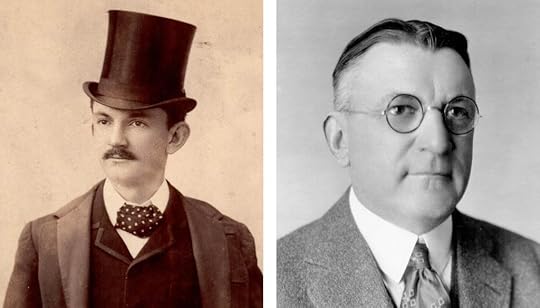
Parker as a young adult and later in life. Courtesy of Peter Pronych and Arden Christen
It was then that Parker decided he could advertise his service to the public through the spoken word and hold public dental demonstrations. He borrowed a horse-drawn wagon from the hotel where he was staying and blasted a horn to attract a crowd. Parker proceeded to lecture roughly 50 to 60 people about the importance of keeping their teeth clean. He then offered to pull the teeth of audience members for 50 cents and unveiled his planned use of hydrocaine. Parker performed several extractions that night.
Parker’s Dental ShowsAfter that first show, he spent years traveling through cities and towns across the U.S. and Canada to pull teeth at a low cost in front of audiences. He also offered dental services out of hotel rooms and eventually opened his own offices. It was in New Brunswick, Canada, where Parker first referred to himself as “Painless Parker.” And the name stuck throughout his career and beyond.
When the outdoor extractions began, Parker signaled to the band to play loud music as a distraction for the patient and to cover up their moans. He typically drew a big crowd, largely of lower-income people who could afford his care. Dr. Pronych says he never found a concrete answer as to whether Parker ever actually paid his patients $5 if they said they felt pain. Still, his biography on Parker’s early career states that some patients reported the experience being “almost dreamlike” whereas others complained of extreme pain — and humiliation.
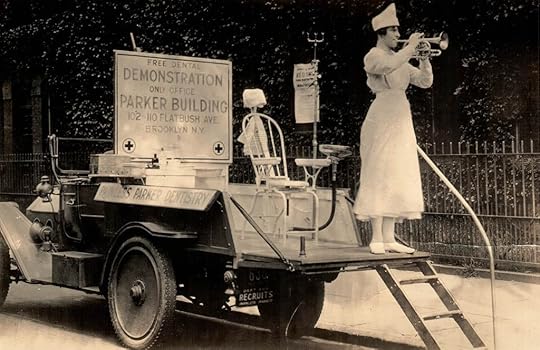
A Painless Parker demonstration in Brooklyn, New York, c. 1910-1915. Courtesy of Peter Pronych and Arden Christen
When it was all over, according to the Kornberg School of Dentistry, Parker placed the teeth he pulled in a bucket resting near his feet.
Some accounts of Parker’s career have also claimed that before performing any actual extractions, Parker would call up a pre-selected volunteer to the stage. With a tooth already in hand, Parker would pretend to pull a molar from the volunteer’s mouth, and the volunteer would claim to have felt no pain. (However, Dr. Pronych notes that he didn’t find evidence of this practice in his research.)
Parker attracted the attention of city authorities and local dentists who questioned his motivations and unconventional advertising methods — holding his dental shows, running newspaper ads touting “painless” dentistry, posting large signs, and soliciting patients in his own unique way. Advertising in traditional dentistry was considered inappropriate and unethical at the time, and Parker was sued on several occasions. His obituary in The New York Times states that he “often had his license revoked but for no great duration.”

A 1908 Painless Parker advertisement. Courtesy of Peter Pronych and Arden Christen
In 1896, Parker found himself low on money after being run out of several towns in New Brunswick, Canada. He and his family moved to New York, where he met William Beebe, a former employee of the famous showman P.T. Barnum. According to The Early Adventures of Painless Parker, Beebe advised Parker to add a six-piece band, gasoline torches, and sometimes a tumbling act or comedian to his program. He also encouraged Parker to ramp up his advertising. Signs on the sides of buildings spelled out claims like “Proclaimed by Public, Press, and Pulpit!” and “Pains and Pangs Positively Prevented!”
While some other dentists mimicked Parker’s advertising methods, they typically didn’t have outdoor dentistry shows and Parker was, by far, the most famous among them, Dr. Pronych says.
The Celebrity DentistBy the end of his career, Parker had launched a line of products — toothpaste and mouthwash, among others — with the Painless Parker brand front and center. He eventually made educational films about caring for your teeth and treated the teeth of animals, including a hippopotamus!

Parker performs a dental procedure on a hippopotamus. Courtesy of Peter Pronych and Arden Christen
Parker attracted so many patients that he opened a chain of dozens of dental offices in the U.S. and Canada. He hired dentists and other staff, employing a system of specialization based on the dentists’ areas of interest and expertise.
In 1913, Parker bought a traveling circus. At The Parker Dental Circus, he’s known to have sat atop an elephant as contortionists, dancing women, and a band performed. (This is the era in which he pulled more than 350 teeth in a single day and turned them into a necklace.)
In 1915, while living in California, the state legislature passed a law that disbarred dentists from practicing using a name other than the one under which they were licensed. Being the showman he was, Parker legally changed his name to Painless Parker so he could continue advertising as such.
Different PerspectivesFor many reasons, Parker’s approach to dentistry was unconventional. He ran into issues with the law and angered more traditional dentists, who said he was unethical in his dental practices and advertising methods.
So, what’s his true legacy? It depends on who you ask.
Dr. Spielman, who feels that Parker ultimately did a “huge disservice” to the profession, says Parker teamed up with “a number of shady characters” (like Beebe) who gave him business acumen and advertising prowess in exchange for the money Parker made for the both of them. “People still talk about him as being reckless and overstepping all boundaries of decency and ethical behavior in a profession that is supposed to be self-governing,” Dr. Spielman says.

A Painless Parker demonstration in New York City’s Times Square. Courtesy of Peter Pronych and Arden Christen
Though he was quick and skillful with his hands, “(Parker) acted like a used car salesman in a profession that mandates ethical standards,” Dr. Spielman says, arguing that Painless provided substandard care by not operating out of an office. Parker threw ethics to the wayside when he advertised himself as “painless,” Dr. Spielman adds, because other dentists also had access to certain anesthetics at the time, and he skirted the law by changing his name.
On the other hand, Dr. Pronych views Parker as a patient advocate ahead of his time, rejected by his colleagues for taking a different approach to dentistry. Speaking to Ripley’s, he says, “(Parker) delivered the actual dental care in the same manner and standard as did all of the other dentists of that era except he used advertising outside of the office to draw patients.”
Parker’s approach to dentistry and advertising also allowed him to educate and bring dental treatment to “the poor and regular people in society,” Dr. Pronych adds. He describes Parker as a “controversial pioneer” in dentistry, which is prevalent today, and an influential figure in advertising more broadly.
“More conventional dentists have termed Painless Parker a fraud, a quack, a disgrace to the profession,” reads a 1949 article in Maclean’s, a Canadian magazine. “In his own defense he says that millions who would have neglected their teeth have gone to dentists only because of him.”
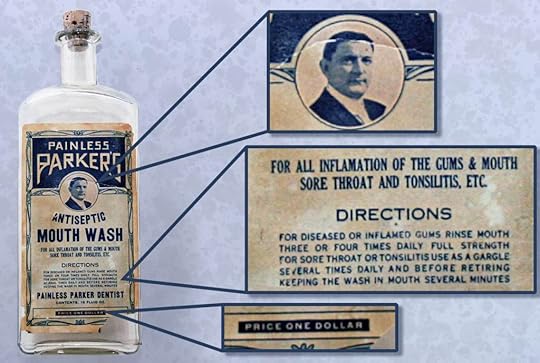
One of Painless Parker’s many products. Copyright 2017 Kornberg School of Dentistry, Temple University
Painless Parker’s LegacyParker’s actions indirectly led to new legislation and professional ethics in dentistry to curb what many perceived as unethical practices by him and other dentists of his time. Today, dentists are permitted to advertise their practice, but they shouldn’t solicit patients using false or misleading information, according to the ADA’s New Dentist Now blog.
He was also among the first dentists to launch a chain of dental offices, and Dr. Pronych says Parker was a pioneer in having his staff treat patients according to their skill sets.
Facing a barrage of lawsuits and growing awareness about the importance of sterilization, Parker decided to shift his focus in 1920 from his street dentistry shows to the E.R. Parker System, his chain of dental offices. He continued to build his brand, though he toned down his advertisements.
In 1948, Bob Hope played dentist “Painless” Potter in the comedy film The Paleface, with the character inspired by a young Painless Parker but bearing almost no resemblance to his actual life.
As for Parker, he died at 80 years old in 1952 after multiple heart attacks, but his legacy — whether bad, good, or somewhere in between — remains very much alive. As orthodontist Dr. Rolf G. Behrents, editor of the American Journal of Orthodontics and Dentofacial Orthopedics, writes, “He was famous and infamous, a celebrity and a scoundrel, a quack and an innovator, a shameless self-promoter and a patient advocate, and a provocateur and a victim; he was admired and respected, and hated, for what he did and how he did it.”
By Jordan Friedman, contributor for Ripleys.com
EXPLORE THE ODD IN PERSON! Discover hundreds of strange and unusual artifacts and get hands-on with unbelievable interactives when you visit a Ripley’s Odditorium!Source: Painless Parker: The Man Who Turned Dentistry Into A Traveling Show
CARTOON 11-17-2021
November 16, 2021
Toyota Takes On Tiny Town With Mini Mirai
Featured in Ripley's Believe It or Not!

The Model Village in Bourton-on-the-Water in Gloucestershire, England, is an exact replica of the town at a 1:9 scale. The miniature copy contains everything you’d expect from its real-life version, including churches, footbridges, and the latest shops. And the accuracy is mindboggling. Landscaping includes bonsai trees pruned regularly to keep them proportionate, and the model relies on locally quarried stone. There’s even a model of the Model Village!
As stores in the city center change, the Model Village gets updated along with the most minute details, including window displays. But the frosting on top of the Model Village cake came in October, when Toyota chose Bourton-on-the-Water to test drive the United Kingdom’s first hydrogen-fueled radio-controlled (RC) car, a 1:10 replica of a Toyota Mirai. Here’s what you need to know about this groundbreaking event.
A Test Drive With a PurposeWhen Toyota set out to create the Mirai with a miniaturized fuel cell, they had one objective in mind: To show the world what’s possible with fuel cell technology at opposite extremes of the mobility scale. To achieve their goals, Toyota turned to Bramble Energy and Tamiya UK for assistance. Bramble Energy specializes in cutting-edge hydrogen fuel innovations and applications, and Tamiya UK crafts hyper-realistic RC vehicles.
Like its full-scale counterpart, the Tamiya RC model comes with a stellar driving range. In fact, it can cover twice the distance of your typical RC vehicle! Showcasing the potential for hydrogen remains a project close to Toyota’s heart. After all, the company has invested more than 20 years into hydrogen research, and the results couldn’t be more exciting.

The model Mirai’s scaled-down components: 1. Hydrogen manifold 2. Hydrogen inlet pipe 3. Electronics control board 4. Hydrogen regulator 5. Hydrogen gas storage canister 6. Fuel cell power terminal 7. Battery pack 8. PCBFC fuel cell range extender 9. Voltage regulator 10. Rear shock absorber 11. Bespoke body-shell in the shape of a new Toyota Mirai
The Future of DrivingMaking the test drive through Bourton-on-the-Water’s Model Village required shrinking a whole fuel cell system. The process proved a significant challenge for the engineers at Bramble Energy, especially when it came to designing the system components compact enough to fit atop the Tamiya TT02 chassis and beneath the frame of the Mirai RC. But the praiseworthy results made the project well worth the effort.
And Toyota isn’t satisfied with miniature RC cars alone. The brand has big plans when it comes to expanding this technology in the years to come. Since launching their first fuel cell car in 2015, Toyota has made significant leaps. They’ve increased fuel cell production to 30,000 units per year. The result? The potential for expansion of fuel cell technology into other areas, including haulage and other forms of transportation. Toyota’s extensive research could even have implications for industrial energy.

Tamiya’s miniature Mirai drives past the church in the Model Village.
As Alistair Brebner of Tamiya UK notes, “We believe these adapted hydrogen-powered Tamiya cars are the first hydrogen fuel cell RC cars in the UK, and they mirror the way full-size vehicles will be powered in the future. It’s been great to see them in action at the model village; they performed really well.” Toyota’s pursuit of this exciting hydrogen cell technology comes with the potential for a whole range of possibilities and profound environmental benefits. But for now, we’re obsessed with the adorable red ride wending its way through one of the quaintest model villages on the planet!
By Engrid Barnett, contributor for Ripleys.com
EXPLORE THE ODD IN PERSON! Discover hundreds of strange and unusual artifacts and get hands-on with unbelievable interactives when you visit a Ripley’s Odditorium!Newly Uncovered Room Gives Intimate Look At Slave Life in Pompeii
Featured in Ripley's Believe It or Not!

Archaeologists recently uncovered an immaculately preserved slave chamber in a Roman villa, a true window into the ancient world. The room still contains the home furnishings that its former occupants once used. Besides these artifacts, a chariot shaft lay on one of the beds, suggesting the slaves used their chamber as a workspace.
In A.D. 79, Mount Vesuvius’s explosion brought life to a permanent standstill, destroying the cities of Pompeii and Herculaneum. Ironically, the same volcanic event that ended these cities also deposited thick layers of ash, leading to the unmatched preservation of places like the slave room. Here’s what you need to know about the secrets the chamber has divulged about everyday life in Rome.
A Time Capsule from Ancient RomeThe slaves’ quarters sit within the Civita Giuliana villa, located just outside Pompeii’s city walls.
The 52-square-foot slave chamber contained a chamber pot, three beds, a wooden chest filled with horse harnesses, and the shaft of a chariot one of the slaves appears to have been mending. The beds included a shorter one for a child, and one small window delivered light into the room. Archaeologists believe a small family may have lived there. The room also served storage purposes, as evidenced by amphorae jars stuffed into one corner.
WATCH: A ‘slave’ room uncovered by archeologists near Pompeii measures 16 square-meters, with a small window high up. It also served as a storage space. Under Roman law slaves were considered property and had no legal personhood https://t.co/wdVH2b6AoV pic.twitter.com/I4Dnn35gjz
— Reuters (@Reuters) November 13, 2021
The excavation’s director, Gabriel Zuchtriegel, argues, “It is certainly one of the most exciting discoveries during my life as an archaeologist, even without the presence of great ‘treasures’ — the true treasure here is the human experience, in this case of the most vulnerable members of ancient society, to which this room is a unique testimony.” Zuchtriegel also notes the cramped and precarious living space that resembled “something between a dormitory and a storage room.”
Discovery at Civita GiulianaFirst excavated in 2017, the Civita Giuliana villa has yielded many other incredible discoveries, too. These include a stable with three horses buried in ash and a ceremonial chariot. Scientists successfully made a plaster cast of one of the equine’s ash molds. In an underground room located beneath the villa, researchers also found the remains of two men: a master and a slave. They used these human forms, created by ash, to make eerie plaster casts of the men’s final poses.
Discoveries continue to be made at Civita Giuliana, in the suburban villa to the north of #Pompeii which has been studied since 2017, and from which – in the servant’s quarters – have already emerged a ceremonial chariot and stable containing the remains of 3 equines. pic.twitter.com/DxgbYQL6ZD
— Pompeii Sites (@pompeii_sites) November 9, 2021
Despite these exciting discoveries, the Civita Giuliana has attracted looters for years, drawn by the allure of robbing the Roman city turned mass gravesite. Tunnels dug in the villa for these nefarious activities have resulted in more than $2 million in damages and a loss of heritage at the site. Nevertheless, stratigraphic excavation of the villa has still contributed significantly to our understanding of what daily life was like in Rome. And there’s hope that renewed public awareness about the incredible treasures of Pompeii could lead to better protection of the site and the stories it has yet to tell us.
By Engrid Barnett, contributor for Ripleys.com
EXPLORE THE ODD IN PERSON! Discover hundreds of strange and unusual artifacts and get hands-on with unbelievable interactives when you visit a Ripley’s Odditorium!Source: Newly Uncovered Room Gives Intimate Look At Slave Life in Pompeii
CARTOON 11-16-2021
November 15, 2021
CARTOON 11-15-2021
November 14, 2021
CARTOON 11-14-2021
Ripley Entertainment Inc.'s Blog
- Ripley Entertainment Inc.'s profile
- 52 followers


